The column pour cold process technique involves pouring layers of soap on top of a column-shaped tool. As more layers are poured, the soap spreads throughout the mold creating fun patterns depending on the shape of your column tool. For this Electric Lemonade Column Pour Cold Process, we used squeeze bottles to creates circular layers of brightly colored soap. After pouring the layers, the soap can be swirled to make more complex designs. To see another example of this technique, check out the Neptune Column Pour Cold Process Tutorial.
Scented with Electric Lemonade Cocktail Fragrance Oil, this soap smells tart and juicy. These bars used the Swirl Quick Mix to ensure the soap stayed at a thin trace for a long period of time. Don’t want to use a swirl mix and want to create your own recipe? Make sure you have at least 60% liquid oils in the recipe to ensure you have enough time to get the column pour to really work well. For tips on creating your own recipe, click here. Also, be sure to use a fragrance oil that does not accelerate trace. Click here for more tips to avoid trace acceleration.
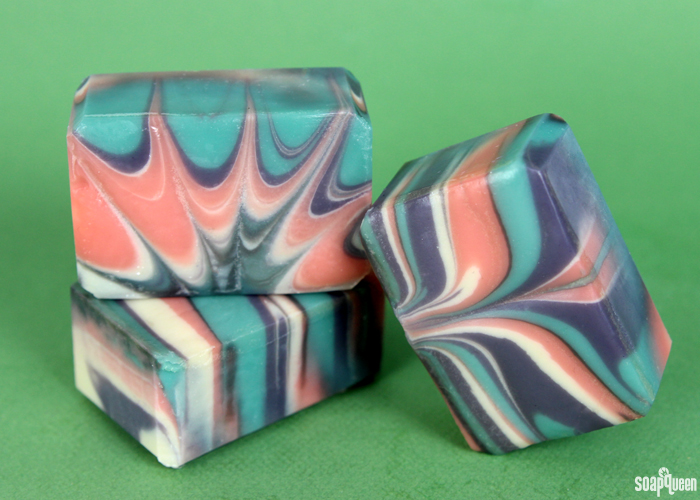
These bars were sent to the first 25 soap swap boxes that arrived to Bramble Berry; I hope those who received them love the fragrance and design! It was so fun to receive all the soap in this year’s cold process soap swap. The team and I were so impressed with the variety and skill in each project. If you’d like to be included in the next swap, be sure to sign up for our newsletter and keep your eyes on the blog and Bramble Berry Facebook page for future announcements.
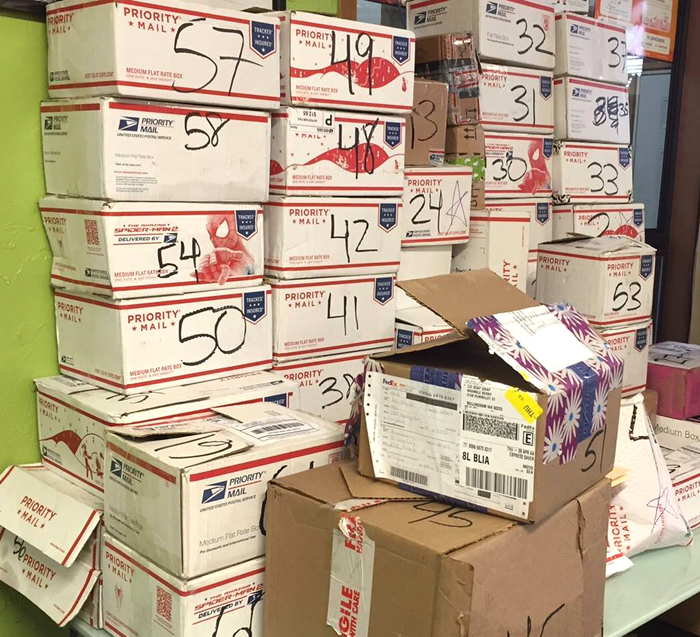 Just a few of the Soap Swap boxes ready and waiting to be swapped!
Just a few of the Soap Swap boxes ready and waiting to be swapped!
What You’ll Need:
36 Bar Unfinished Birchwood Mold
131 oz. Swirl Quick Mix
18.1 oz. Sodium Hydroxide Lye
43.2 oz. Distilled Water
10 oz. Electric Lemonade Cocktail Fragrance Oil
Neon Blue Raspberry Colorant
Tangerine Wow! Colorant
Ultramarine Violet Oxide Pigment
Titanium Dioxide
Black Oxide
Optional: 2 Squeeze Bottles
 Click here to add everything you need for this project to your Bramble Berry shopping cart! Don’t want to use a swirl mix and want to create your own recipe? Make sure you have at least 60% liquid oils in the recipe to ensure you have enough time to get that swirl to really work well. Tips for creating your own recipe here.
Click here to add everything you need for this project to your Bramble Berry shopping cart! Don’t want to use a swirl mix and want to create your own recipe? Make sure you have at least 60% liquid oils in the recipe to ensure you have enough time to get that swirl to really work well. Tips for creating your own recipe here.SAFETY FIRST: Suit up for safe handling practices! That means goggles, gloves and long sleeves. Make sure kids, pets, and other distractions and tripping hazards are out of the house or don’t have access to your soaping space. Always soap in a well-ventilated area.
COLOR PREP: To ensure that the Titanium Dioxide blends smoothly into the soap batter, we recommend micronizing it before dispersing it in oil. Please note this is an optional tip but it does help with the titanium dioxide clumping in the soap =) To micronize colorant, simply use a coffee grinder to blend the colorant to break up any clumps of color and prevent streaks of white from showing in the final soap. We like to use a coffee grinder that has a removable, stainless steel mixing area for easy cleaning. Then, disperse 3 teaspoons of each colorant into 3 tablespoons of sunflower or sweet almond oil (or any other liquid oil). Disperse 1 teaspoon Black Oxide into 1 tablespoon light weight liquid oil. Then disperse 3 teaspoons of Tangerine Wow! Colorant and Neon Blue Raspberry into 3 tablespoons light weight liquid oil in separate containers. Finally, disperse 4 teaspoons Ultramarine Violet Oxide Pigment into 4 tablespoons lightweight liquid oil. Use a mini mixer to get clumps worked out smoothly. Prepping your colors in the beginning will allow you to work quickly and give you more time to work with your soap.
MOLD & COLUMN PREP: Before you begin, be sure to line the mold with freezer paper. Click here to learn how to line the mold yourself. If you choose to use the squeeze bottle to create the column pour, remove the caps from the squeeze bottles. Wrap the top of each bottle with tape to cover the opening. Try to make the tape as smooth and even as possible, as large creases could effect the design as the soap moves down the bottles. If you don’t have squeeze bottles, you can use any other cold process safe column shape. Just keep in mind that the size and shape will affect the patter and size of the layers. You may want to weight the bottles down. I found it a bit easier when they were heavier to pour over them.
ONE: Slowly and carefully add the lye to the water and gently stir until the lye has fully dissolved and the liquid is clear. Set aside to cool.
TWO: Fully melt the Swirl Recipe Quick Mix and pour into a large container that holds 200 oz. Once the lye water and the oils have cooled to 130 degrees or below (and are ideally within 10 degrees of each other), add the lye water to the oils and stick blend until thin trace. If you’d like a harder bar of soap that releases faster from the mold, you can add sodium lactate to the cooled lye water. Use 1 teaspoon of sodium lactate per pound of oils in the recipe. For this recipe, you’d add about 8 tsp. sodium lactate.
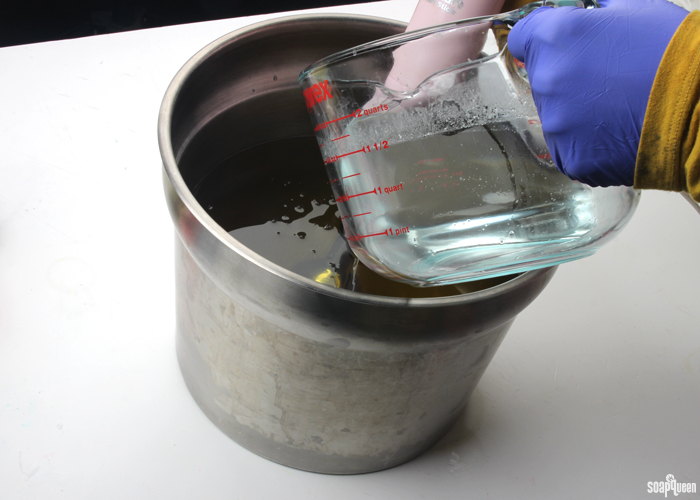
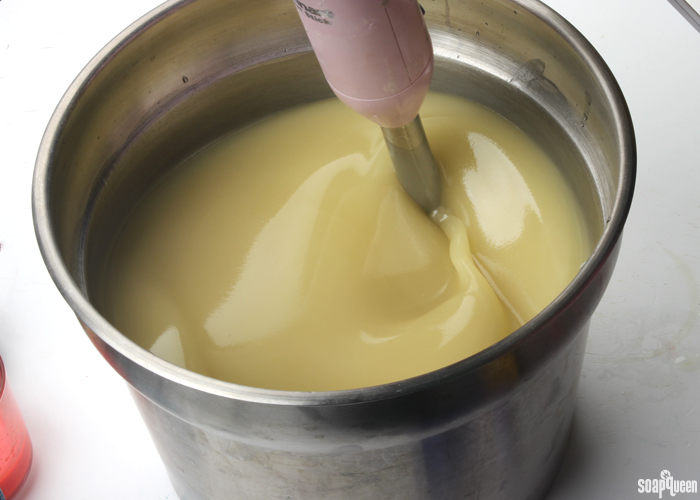
THREE: Once you’ve reached a thin trace, split the batter into three large containers of about 5.5 cups each. Then, split off the remaining soap into two smaller containers of about 900 mL each. To these containers, whisk in the dispersed colorants using the amounts below.
- Container A (5.5 cups): 3 Tbs. Tangerine Wow! Colorant
- Container B (5.5 cups): 3 Tbs. Neon Blue Raspberry Colorant + 1 tsp. Titanium Dioxide
- Container C (5.5 cups): 4 Tbs. Ultramarine Violet Pigment + 1/4 tsp. Black Oxide
- Container D (900 mL): 3 Tbs. Titanium Dioxide
- Container D (900 mL): 1 tsp. Black oxide
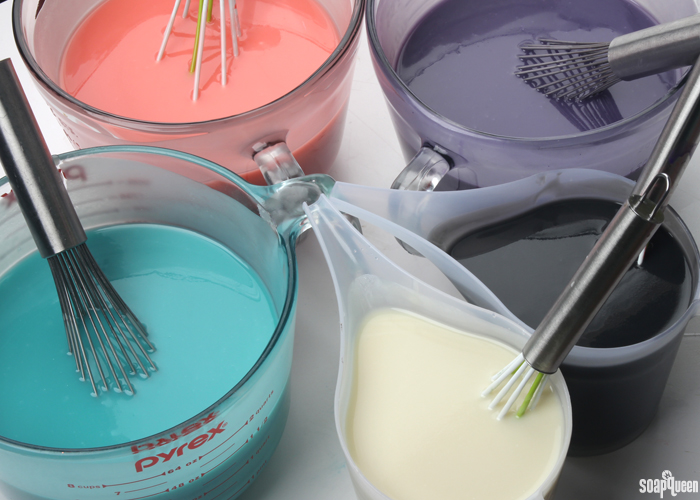
FOUR: Add the fragrance oil proportionally into each container of soap. It’s okay to eyeball it! Use a whisk to thoroughly mix in the fragrance oil.
FIVE: Decide on a color order and stick with it for the entirety of the pour. The order that I used was purple, white, orange, black, and blue. Pour the first color in the center of the squeeze bottles while counting to 3. Repeat this step with the other colors, again counting to three during each pour to keep the layers a similar size. Repeat the process until the containers have been emptied. Whisk each color after a few pours to help keep the soap fluid and avoid any graininess.
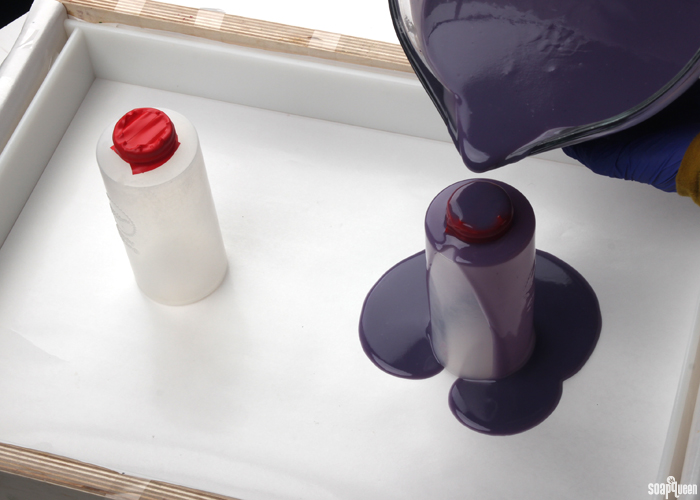

SIX: Once all the soap has been poured, slowly and carefully remove the squeeze bottles from the soap. Have a container waiting nearby to set the bottles in. Once the bottles have been removed, firmly tap the mold on the counter to help settle the soap. Because the mold is so large, you may want a soapy helper for this! Finally, if you have a few drops of white soap leftover, add a dollop of white soap in the center of the layers. This is optional, but the white soap on top gives a nice contrast.
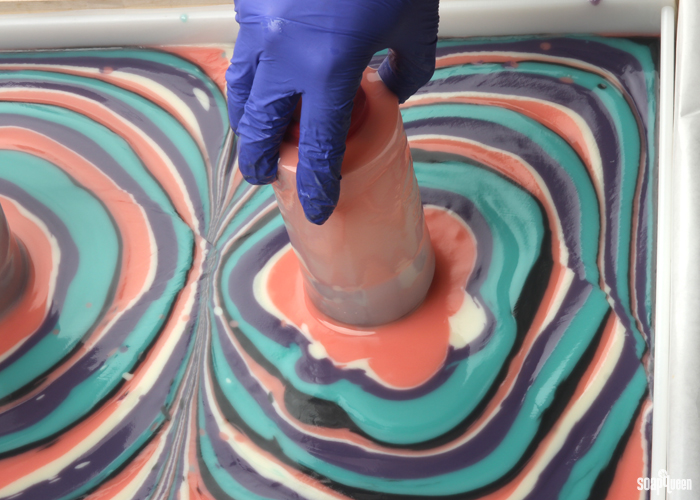 SEVEN: Insert a dowel or chopstick into the center of each column pour, and swirl outward in a circular motion. Do not insert the dowel or chopstick all the way through the soap, only swirl the top. Once you reach the end of the circle created by the pour, swirl the other circle.
SEVEN: Insert a dowel or chopstick into the center of each column pour, and swirl outward in a circular motion. Do not insert the dowel or chopstick all the way through the soap, only swirl the top. Once you reach the end of the circle created by the pour, swirl the other circle.
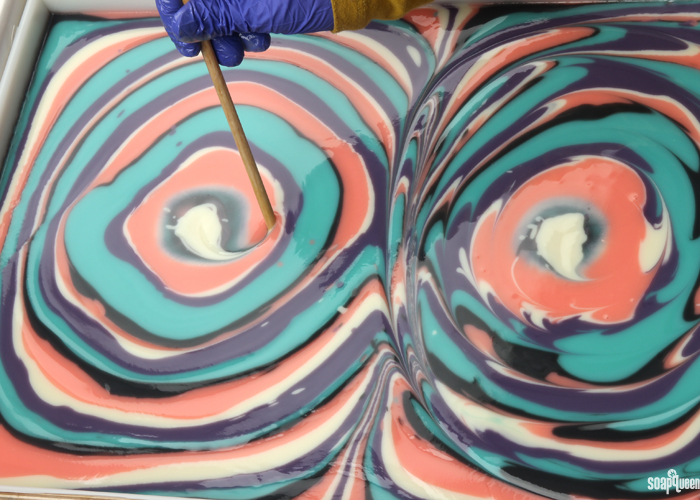 EIGHT: Clean off your chopstick or dowel, and insert it into the center of each circular pattern. Do not insert the swirling tool all the way through the soap, only swirl the top. Drag the dowel straight to the edges of the mold. Repeat this process for the other circular pattern created by the pour.
EIGHT: Clean off your chopstick or dowel, and insert it into the center of each circular pattern. Do not insert the swirling tool all the way through the soap, only swirl the top. Drag the dowel straight to the edges of the mold. Repeat this process for the other circular pattern created by the pour.
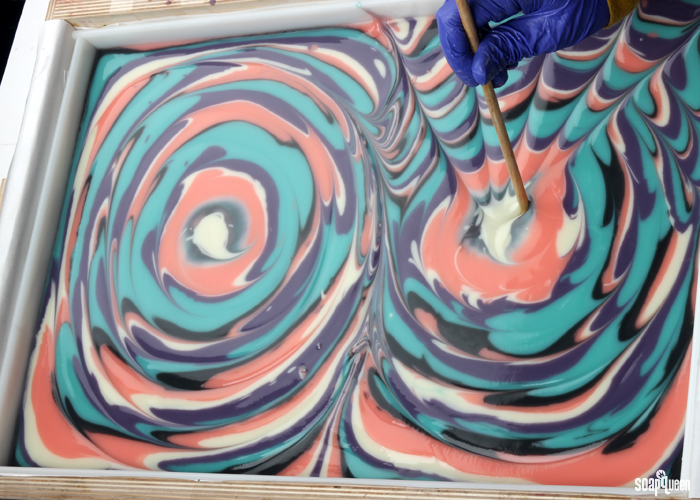
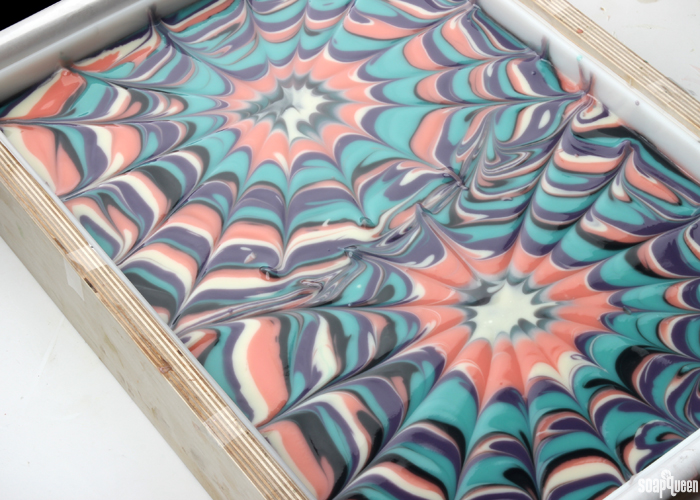 NINE (optional): Finish the soap by inserting the 36 bar divider set. Click here to learn how to assemble the divider sets for birchwood soap molds.
NINE (optional): Finish the soap by inserting the 36 bar divider set. Click here to learn how to assemble the divider sets for birchwood soap molds.
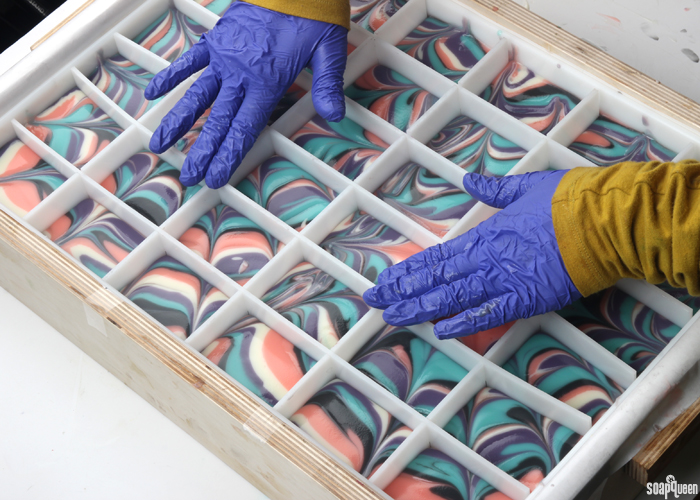 TEN: Spray the soap with 99% isopropyl alcohol to prevent soda ash. To help the colors pop, we promoted gel phase by placing the lid onto the mold, and setting the mold on a heating pad set to medium for 30 minutes. Learn more about gel phase here.
TEN: Spray the soap with 99% isopropyl alcohol to prevent soda ash. To help the colors pop, we promoted gel phase by placing the lid onto the mold, and setting the mold on a heating pad set to medium for 30 minutes. Learn more about gel phase here.
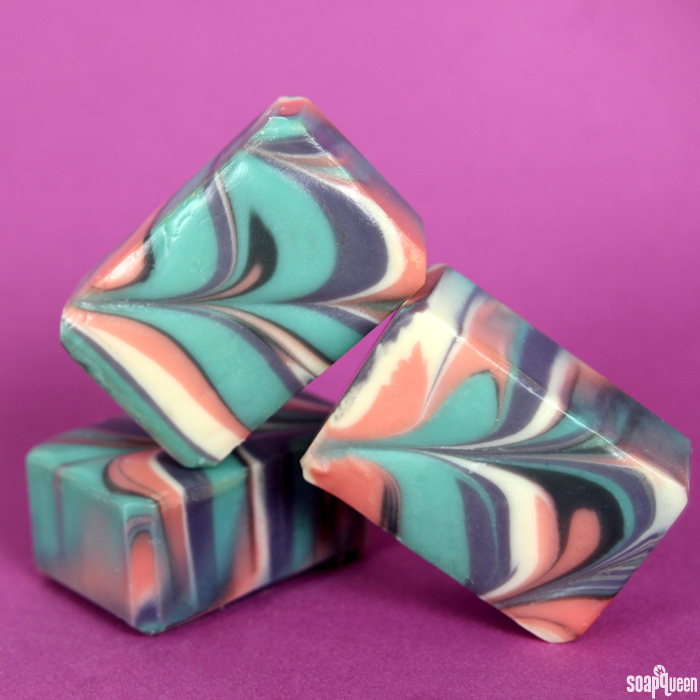 Have you tried the column-pour technique? I love the design it creates!
Have you tried the column-pour technique? I love the design it creates!
- 36 Bar Unfinished Birchwood Mold
- 131 oz. Swirl Quick Mix
- 18.1 oz. Sodium Hydroxide Lye
- 43.2 oz. Distilled Water
- 10 oz. Electric Lemonade Cocktail Fragrance Oil
- Neon Blue Raspberry Colorant
- Tangerine Wow! Colorant
- Ultramarine Violet Oxide Pigment
- Titanium Dioxide
- Black Oxide
- Optional: 2 Squeeze Bottles
- Slowly and carefully add the lye to the water and gently stir until the lye has fully dissolved and the liquid is clear. Set aside to cool.
- Fully melt the Swirl Recipe Quick Mix and pour into a large container that holds 200 oz. Once the lye water and the oils have cooled to 130 degrees or below (and are ideally within 10 degrees of each other), add the lye water to the oils and stick blend until thin trace. If you’d like a harder bar of soap that releases faster from the mold, you can add sodium lactate to the cooled lye water. Use 1 teaspoon of sodium lactate per pound of oils in the recipe. For this recipe, you’d add about 8 tsp. sodium lactate.
- Once you’ve reached a thin trace, split the batter into three large containers of about 5.5 cups each. Then, split off the remaining soap into two smaller containers of about 900 mL each. To these containers, whisk in the dispersed colorants using the amounts below.
Container A (5.5 cups): 3 Tbs. Tangerine Wow! Colorant
Container B (5.5 cups): 3 Tbs. Neon Blue Raspberry Colorant + 1 tsp. Titanium Dioxide
Container C (5.5 cups): 4 Tbs. Ultramarine Violet Pigment + ¼ tsp. Black Oxide
Container D (900 mL): 3 Tbs. Titanium Dioxide
Container D (900 mL): 1 tsp. Black oxide - Add the fragrance oil proportionally into each container of soap. It’s okay to eyeball it! Use a whisk to thoroughly mix in the fragrance oil.
- Decide on a color order and stick with it for the entirety of the pour. The order that I used was purple, white, orange, black, and blue. Pour the first color in the center of the squeeze bottles while counting to 3. Repeat this step with the other colors, again counting to three during each pour to keep the layers a similar size. Repeat the process until the containers have been emptied. Whisk each color after a few pours to help keep the soap fluid and avoid any graininess.
- Once all the soap has been poured, slowly and carefully remove the squeeze bottles from the soap. Have a container waiting nearby to set the bottles in. Once the bottles have been removed, firmly tap the mold on the counter to help settle the soap. Because the mold is so large, you may want a soapy helper for this! Finally, if you have a few drops of white soap leftover, add a dollop of white soap in the center of the layers. This is optional, but the white soap on top gives a nice contrast.
- Clean off your chopstick or dowel, and insert it into the center of each circular pattern. Do not insert the swirling tool all the way through the soap, only swirl the top. Drag the dowel straight to the edges of the mold. Repeat this process for the other circular pattern created by the pour.
- (Optiona) Finish the soap by inserting the 36 bar divider set. Click here to learn how to assemble the divider sets for birchwood soap molds.
- Spray the soap with 99% isopropyl alcohol to prevent soda ash. To help the colors pop, we promoted gel phase by placing the lid onto the mold, and setting the mold on a heating pad set to medium for 30 minutes. Allow to stay in the mold for 3-4 days, and cure for 4-6 weeks.
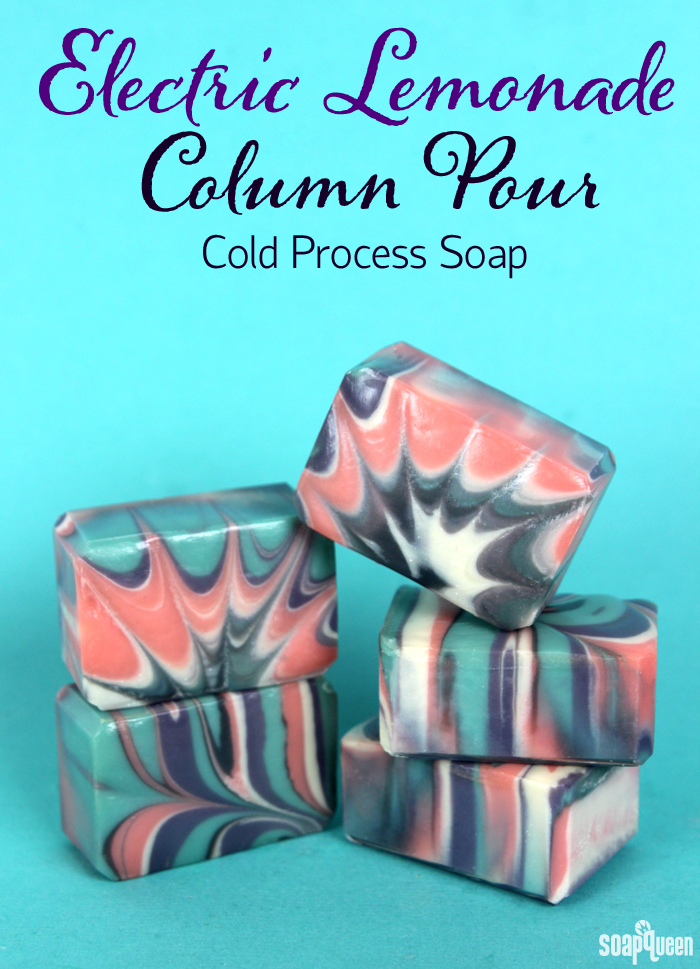
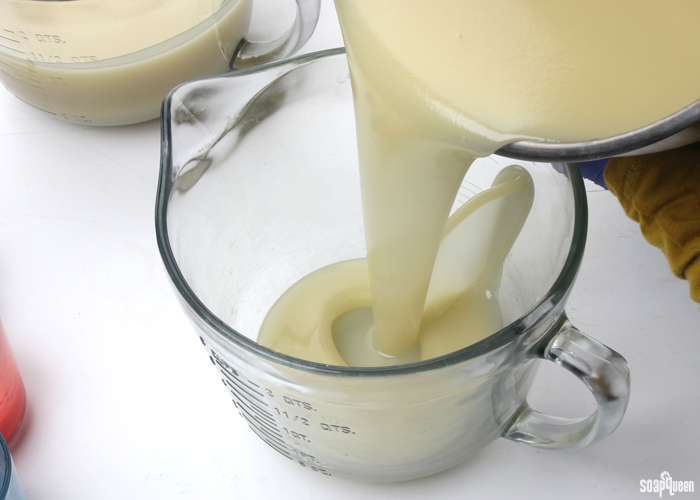
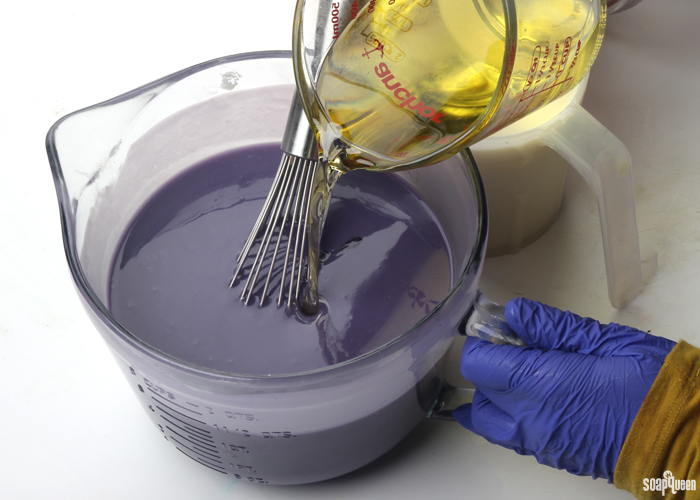

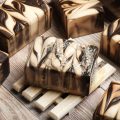
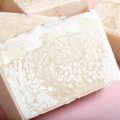

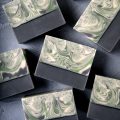
I just did this last night and cut it this morning. Although I used my recipe and other colors, I got the idea and basic instructions here and it turned out great. I’ve been wanting to try it for a long time and just got around to it because I’m going to be making 160 bars this week for a church event at the end of July. Thanks for the instructions and inspiration. I’ll be doing the Sahara Sunset sometime this week!
Check it out on youtube under theorgelmeister
This recipe is perfect for a large event, I’m glad you got to give it a try! Can’t wait to see how it turns out. 🙂
-Kelsey with Bramble Berry
Sahara Sunset Cold Process Tutorial: https://www.soapqueen.com/bath-and-body-tutorials/cold-process-soap/sahara-sunset-cold-process-soap-tutorial/
This was SO MUCH FUN! I just finished cleaning up after trying a column pour. I used a smaller box, lined. A basic coconut, olive, palm recipe with shea butter and castor and the colors I had on hand. Since it was a smaller recipe, I used tall skinny shot glasses for the columns. What a blast. It’s sitting on a reptile warming mat, covered with a beach towel. It is obviously a first effort, I added the fragrance (pineapple cilantro-YUM) a little past light trace, so it was pudding by the time I finished. No perfect rings, but it still made a very interesting pattern. I love making soap. I love Brambleberry!!!
That’s awesome BethAnn, so glad you had a good time soaping! This pattern is so fun because each bar looks a bit different. I really like watching the soap slide down the bottles too. If you have a picture of the finished soap, we’d love to see it on our Facebook page. Thanks so much for your sweet comment too! 🙂
Bramble Berry Facebook: https://www.facebook.com/BrambleBerry/
-Kelsey with Bramble Berry
Pineapple Cilantro Fragrance Oil: https://www.brambleberry.com/Pineapple-Cilantro-Fragrance-Oil-P3873.aspx
Hello again !
I’ve been making soap for some months now, and I can say that I’m very very happy with this new hobby. I’m not planning on selling soap, -or at least NOT in the near future… instead I’ve been using my bars of soap for my family and I, and as presents for my VERY special friends ; )
However, in the last couple of days I’ve been feeling a little puzzled that my skin (face and body) seems to be getting a bit dry. I don’t know how I can explain it, since I’ve only been using my soap and I’ve been superfatting all of my recipes to 5%. Lots of use of goat’s milk and many skin loving oils (not just coconut, which I know could cause the dryness).
Can you think of any possible explanations or solutions? I appreciate your help in advance : )
Hi Rosy!
Isn’t soap making so fun? I started about a year ago and can’t get enough of it. 🙂
It sounds like your recipe is very luxurious and skin loving. However, even if I use soft soap, I find I still need moisturizer. Sometimes skin just needs a little extra hydration!
You may also want to talk to a dermatologist and see if they have any suggestions! They would know more about how to help with dry skin. 🙂
-Kelsey with Bramble Berry
thank you Kelsey !!
You’re welcome! 🙂
Hi! I love this recipe, just like all your others! 🙂
Why do you swirl only the top layer? Wouldn’t it look really cool if you swirled the entire way through?
Thanks!
So glad you love the recipe Robin! We love the look of the layers inside and the swirl on top. You can definitely swirl the whole soap if you like! That would look beautiful as well. 🙂
-Kelsey with Bramble Berry
Hi Kelsey,
This might be a silly question, but what else could I use as the columns? Could I just turn a glass cup upside down and pour over that? Or would that somehow be bad due to the saponification temperatures?
Thanks! I just ordered my 18 bar birchwood mold and CANNOT WAIT for it to arrive! Lots of soap making in the next few weeks! 🙂
Hi Robin!
You can use almost any column shape you like! We’ve used pieces of cardboard, plastic drink bottles, etc. A glass cup would work great as well.
I would recommend steering clear of aluminum. Lye reacts with aluminum and creates a dangerous toxic gas.
Also, thanks so much for your order! Have fun making lots of soap. 🙂
-Kelsey with Bramble Berry
18 Bar Unfinished Birchwood Mold: https://www.brambleberry.com/18-Bar-Unfinished-Birchwood-Mold-P5168.aspx
Hi Robin, I’m going to try this one shortly too! I just found a small, square, wooden furniture leg that I’m excited to try. It’s unfinished, smooth, and about 8″ tall by 1.5″ square. It was about $2 at Lowe’s. 🙂 Good luck!
That’s awesome, what a great use of leftover furniture! After awhile, lye can start to degrade wood. However, you should get a least a couple uses out of it! You can also wrap the leg in plastic wrap to protect the wood. 🙂
-Kelsey with Bramble Berry
Hi,
I am from Myanmar. After seeing this, I am interested in doing this. I think we cannot buy soap making material here and also for chemical. What will be the best way to try doing it with natural ingredient. Is there any way to do with natural ingredients please provide me to try.
Later on, I will find the way how to buy material and chemical.
Hi KS!
Soap, by definition, is a chemical reaction between oils and lye. This process is called saponification. During saponification, the lye gets used up and creates soap. That means you can’t technically have soap without sodium hydroxide lye. Read more in the Where’s the Lye post: http://www.soapqueen.com/bath-and-body-tutorials/cold-process-soap/wheres-the-lye-2/
You can make melt and pour soap! Melt and pour soap has already turned into soap, meaning you’re not handling the chemicals. You may check and see if there are any places in Myanmar that sell melt and pour bases. 🙂
You can also learn more about making soap in the Beginning Soaper Resource Roundup: http://www.soapqueen.com/bramble-berry-news/beginning-soaper-resource-roundup/
-Kelsey with Bramble Berry
Oh I LOVE those colours. It really turned out well. Thanks for sharing this.
So glad you love the colors! I’m a big fan too. Also, you’re welcome! 🙂
-Kelsey with Bramble Berry
OMG !! This is beautiful !! got to try this… will any other mold work the same? Does it have to be a birchwood or can we achieve a similar effect with a silicon mold?
Thank you for sharing such beautiful work of art : ) LOVE IT !!
Hi Rosy!
So glad you love it Rosy! You can use a silicone mold for this technique, but it will be a slightly different look. The large birchwood molds allow the soap to flow out and form a pattern, while a thinner silicone mold will have a smaller pattern. It will still look beautiful though! 🙂
-Kelsey with Bramble Berry
thank you Kelsey !!
You’re welcome Rosy. 🙂